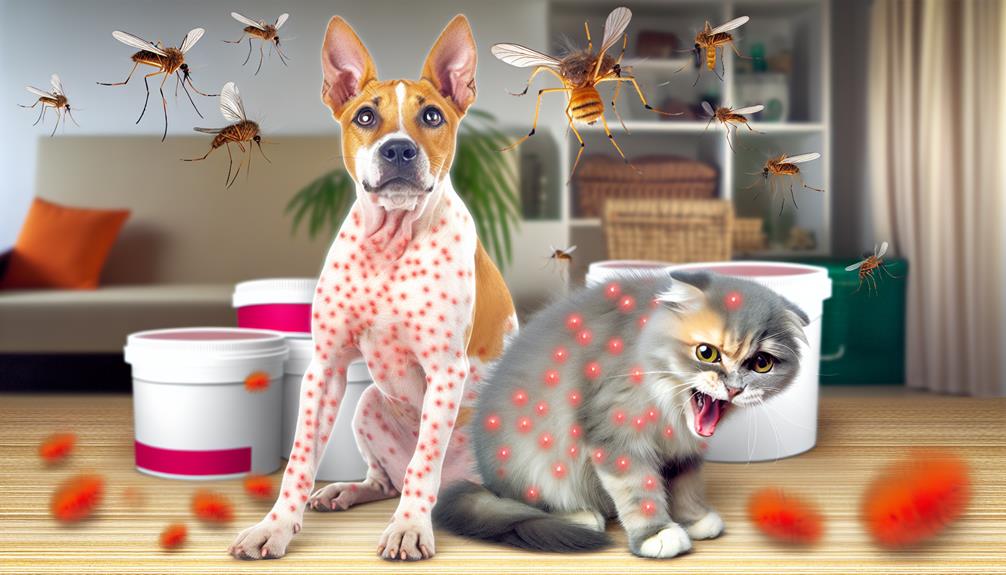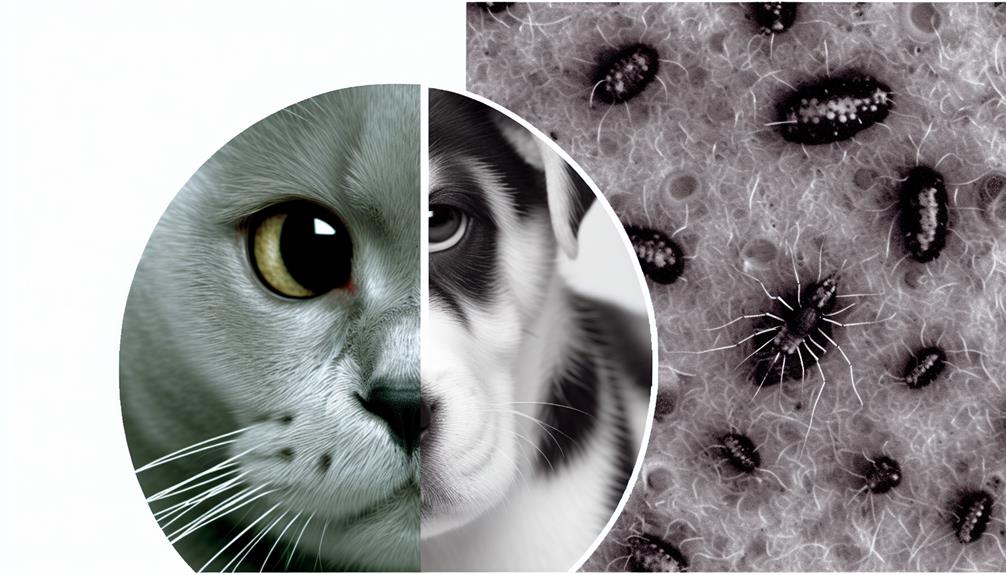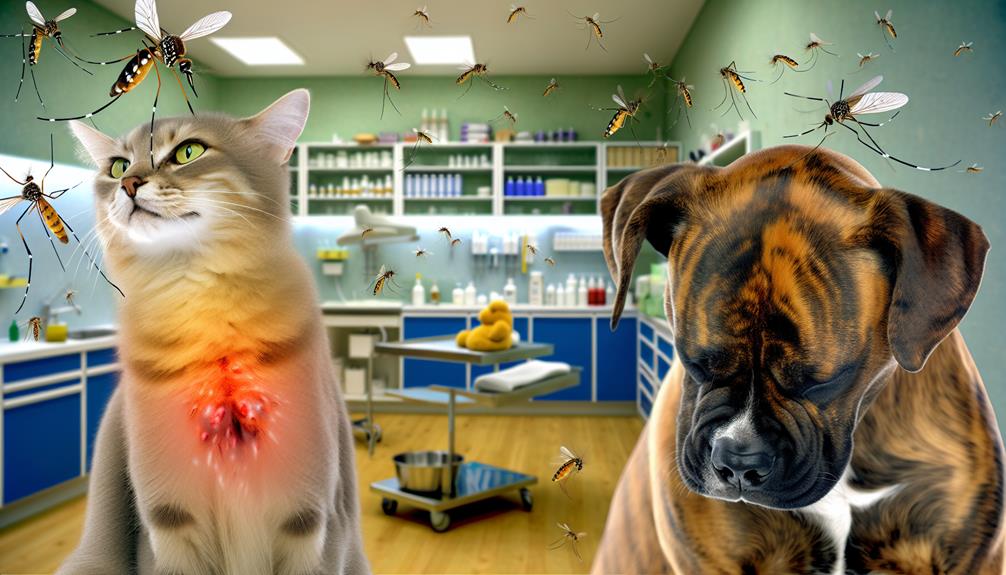You might not realize that mosquito bites can cause serious health issues for your pets beyond just minor irritation. Cats and dogs can suffer from allergic reactions, which often lead to intense itching and swelling. Additionally, these bites can transmit diseases like heartworm in dogs and West Nile virus in both species, causing symptoms that are far more severe than you'd expect. If left untreated, excessive scratching can lead to secondary bacterial infections. Wondering how to protect your furry friends and what other risks are involved? Let's explore further.
Heartworm Disease in Dogs
Heartworm disease in dogs, caused by the parasitic worm *Dirofilaria immitis*, poses a significant health risk, especially in regions where mosquitoes are prevalent. Understanding heartworm transmission and symptoms is vital for effective prevention and management. Mosquitoes serve as vectors for heartworm larvae, which they pick up from infected animals and transmit to healthy dogs through bites. Once inside the host, the larvae mature into adult worms, primarily residing in the pulmonary arteries and the heart.
Recognizing heartworm symptoms early is essential for timely intervention. In the initial stages, your dog might not exhibit any noticeable signs. As the disease progresses, you might observe mild persistent coughing, lethargy, and reduced exercise tolerance. In advanced cases, symptoms can escalate to severe respiratory distress, heart failure, and even sudden death. A clinical diagnosis often requires blood tests, radiographs, and echocardiography to confirm the presence of adult worms and assess the severity of the disease.
Preventive measures are highly effective and include monthly prophylactic medications that target the larval stages before they can mature. It's important to administer these treatments consistently, especially in high-risk areas where mosquito populations are dense. Additionally, regular veterinary check-ups and annual testing for heartworms can help detect infections early, improving outcomes for your dog. Remember, heartworm disease is not just a seasonal concern; mosquitoes can thrive year-round in certain climates, necessitating ongoing vigilance. By understanding heartworm transmission and symptoms, you can take proactive steps to safeguard your dog's health against this potentially life-threatening condition.
Feline Mosquito Hypersensitivity
When a cat experiences Feline Mosquito Hypersensitivity, the clinical manifestation can be distressing both for the pet and its owner. This condition occurs when a cat develops an exaggerated immune response to mosquito saliva, resulting in a variety of dermatological symptoms. It's important to recognize these signs early to manage the condition effectively.
Clinically, you might observe intense pruritus (itchiness), which leads to excessive grooming and scratching. The affected areas often include the nose, ears, and less commonly, the paws. You might notice erythema (redness), papules (small raised bumps), and in severe cases, ulcerations or crusts. This hypersensitivity can greatly alter feline behavior, making your cat more irritable and less interactive.
Emotional Impact of Feline Mosquito Hypersensitivity
| Observation | Emotional Response |
|---|---|
| Intense itching and grooming | Anxiety and frustration |
| Redness and skin lesions | Worry and helplessness |
| Behavior changes | Sadness and concern |
For effective mosquito avoidance, consider environmental controls such as keeping your cat indoors during peak mosquito activity periods (dawn and dusk). Utilize window screens and mosquito repellents that are safe for pets. Veterinary consultation is important for an appropriate diagnosis and treatment plan, which may include antihistamines, corticosteroids, or topical therapies.
Feline Mosquito Hypersensitivity is an evidence-based condition with clear clinical indicators. By understanding the symptoms and taking proactive steps, you can help alleviate your cat's discomfort and improve its quality of life. Regular check-ups and maintaining a mosquito-free environment are crucial in managing this condition effectively.
Allergic Reactions in Pets

Just as Feline Mosquito Hypersensitivity can notably impact a cat's well-being, other allergic reactions in pets can present similarly distressing symptoms. When your pet experiences an allergic reaction to mosquito bites, you might notice erythema (redness), pruritus (itchiness), and localized swelling. These symptoms can lead to secondary complications, such as bacterial infections due to excessive scratching.
Pet allergy management requires a multifaceted approach. Initially, it's essential to minimize your pet's exposure to mosquitoes. This can involve using pet-safe insect repellents, ensuring your home is mosquito-free, and avoiding outdoor activities during peak mosquito activity times.
If your pet has already been bitten, mosquito bite treatment becomes necessary. Topical corticosteroids can be applied to reduce inflammation and itching. Antihistamines may also be administered to alleviate allergic symptoms. In more severe cases, systemic corticosteroids might be required to control the reaction.
Monitoring for signs of secondary infection is crucial in the days following a bite. Symptoms like increased redness, warmth, or pus may indicate an infection, necessitating antibiotic treatment. Always consult your veterinarian before administering any medication, as dosages can vary based on your pet's size and species.
Implementing a consistent pet allergy management plan can appreciably improve your pet's quality of life. Regular check-ups with your veterinarian will help tailor this plan to your pet's specific needs. Additionally, keeping a detailed record of your pet's reactions and treatments will provide valuable information for ongoing care.
West Nile Virus Risks
West Nile Virus (WNV) poses significant health risks to both cats and dogs, though it is more frequently associated with birds and humans. Understanding the transmission dynamics is vital for mitigating these risks. WNV is primarily transmitted by mosquitoes, which act as vectors by biting infected birds and then subsequently biting mammals, including your pets. Although cats and dogs are less susceptible than other species, they can still contract the virus under certain conditions.
In cats, WNV infection can manifest through clinical signs such as fever, lethargy, and decreased appetite. Neurological symptoms, although rare, can also occur, including tremors and ataxia. Dogs, on the other hand, might show milder symptoms or remain asymptomatic, making early detection challenging. The risk of severe illness is generally lower in dogs compared to cats, but vigilance is still essential.
Preventing West Nile Virus involves minimizing mosquito exposure. Regular use of veterinarian-approved insect repellents can reduce the likelihood of mosquito bites. Ensuring your pets avoid peak mosquito activity times, typically dawn and dusk, is also advisable. Additionally, eliminating standing water around your home can disrupt mosquito breeding cycles, thereby reducing the risk of WNV transmission.
While there is no specific antiviral treatment for WNV in pets, supportive care can mitigate symptoms and improve recovery outcomes. Keeping your pet hydrated and comfortable while monitoring their health closely is essential. If you suspect WNV infection, a veterinary consultation is imperative for accurate diagnosis and appropriate care. By understanding and addressing the transmission dynamics of West Nile Virus, you can better protect your cats and dogs from this potential threat.
Skin Infections in Cats and Dogs

When your cat or dog gets a mosquito bite, they can be at risk for bacterial infections, especially if the bite becomes irritated or is scratched excessively. Allergic reactions may also occur, presenting symptoms such as redness, swelling, and intense itching. Identifying and treating these symptoms promptly is essential to prevent secondary complications.
Bacterial Infection Risks
Bacterial infection risks from mosquito bites in cats and dogs can pose significant health concerns. When a mosquito bites your pet, it can serve as a vector for various pathogens, leading to bacterial transmission. The subsequent infection can manifest through various infection symptoms such as redness, swelling, and localized pain at the bite site. More severe complications may develop if the bacteria spread, potentially resulting in systemic infections.
The most common bacterial infections from mosquito bites include cellulitis and abscesses. Cellulitis is a diffuse skin infection characterized by redness, warmth, and tenderness, while abscesses are localized collections of pus that can cause significant discomfort. If left untreated, these conditions can progress, requiring more intensive medical intervention.
To diagnose these infections, veterinarians often conduct physical examinations and, if necessary, bacterial cultures to identify the specific pathogen responsible. Treatment typically involves the administration of antibiotics, either topically or systemically, depending on the severity of the infection. In some cases, surgical intervention may be required to drain abscesses.
It's essential to monitor your pet for any signs of infection following mosquito exposure and seek veterinary care promptly to mitigate potential complications.
Allergic Reaction Symptoms
In addition to bacterial infections, allergic reactions from mosquito bites in cats and dogs can lead to significant skin issues. When your pet experiences an allergic reaction, their immune system releases histamines that cause itchy skin and swelling bumps. These symptoms are not just minor irritations; they can escalate into more severe dermatological problems if not addressed promptly.
You might notice your pet scratching excessively, which can exacerbate the condition, leading to open sores and secondary infections. It's vital to identify these signs early. Swelling bumps are often the first visible indication of an allergic response. These raised, red lesions can be localized or spread across a larger area, depending on the severity of the reaction.
Veterinary intervention is essential for managing these symptoms. Antihistamines and corticosteroids are commonly prescribed to reduce itching and inflammation. Additionally, topical treatments may be recommended to soothe the skin and prevent further infection. It's also advisable to use preventive measures against mosquito bites, such as repellents specifically designed for pets.
Monitoring your pet's behavior and skin condition is key. If you observe persistent itchy skin and swelling bumps, consult your veterinarian immediately for a thorough examination and appropriate treatment plan.
Mosquito-Borne Parasites
Mosquito-borne parasites present a significant health risk to both cats and dogs, causing severe and sometimes fatal diseases. The mosquito lifecycle plays an essential role in the spread of these parasites. Female mosquitoes, after feeding on the blood of an infected host, can transmit parasites to other animals through subsequent bites. This process of parasite transmission is responsible for the spread of diseases such as heartworm (Dirofilaria immitis) in dogs and cats.
Heartworm is one of the most dangerous mosquito-borne parasites affecting pets. In this condition, the larvae (microfilariae) enter the bloodstream through a mosquito bite and mature into adult worms residing in the heart, lungs, and associated blood vessels. The presence of adult heartworms can lead to severe cardiovascular and respiratory distress, ultimately proving fatal if left untreated.
Cats and dogs can also be affected by other mosquito-borne parasites, including those causing diseases like West Nile virus and Eastern equine encephalitis. Although less common in pets than in humans, these viral infections can cause neurological symptoms such as seizures, ataxia, and behavioral changes. These viruses have a complex transmission cycle involving birds as the primary reservoir hosts, with mosquitoes acting as vectors that bridge the infection to mammals.
Recognizing the signs of mosquito-borne parasitic infections is vital. Symptoms can include coughing, lethargy, weight loss, and difficulty breathing in heartworm cases. Early diagnosis and intervention are essential, as many of these conditions are manageable if treated promptly. Your veterinarian can perform diagnostic tests such as blood smears and antigen tests to confirm the presence of parasites and recommend appropriate treatment protocols.
Prevention and Protection Tips

To mitigate risks associated with mosquito bites, consider using veterinarian-approved repellents specifically formulated for pets. Ensuring safe outdoor practices, such as avoiding peak mosquito activity times and utilizing screens or nets, can further protect your cat or dog. Regular application of these measures greatly reduces the likelihood of mosquito-borne diseases.
Effective Repellent Options
When it comes to safeguarding your pets from mosquito bites, utilizing effective repellent options is essential. Natural repellents, such as essential oils like citronella, eucalyptus, and lavender, can be advantageous. However, it's critical to verify these substances are appropriately diluted and safe for your specific pet, as some animals may have sensitivities or allergies. Consulting your veterinarian before applying any natural repellent is highly recommended.
Topical solutions offer another layer of protection. Products containing permethrin or pyrethrin are commonly used in topical formulations for dogs. These compounds are effective in repelling mosquitoes but should never be used on cats due to their toxic nature to felines. Instead, you might consider products specifically formulated for cats, such as those containing etofenprox.
Additionally, there are combination topical solutions that not only repel mosquitoes but also protect against other parasites, including fleas and ticks. Always choose a product that is veterinarian-approved and follow the application instructions meticulously to avoid any adverse reactions.
Safe Outdoor Practices
Guaranteeing the safety of your pets outdoors involves implementing a combination of preventive measures and protective strategies. During outdoor playtime, it's essential to choose pet friendly environments that minimize exposure to mosquitoes. Avoid areas with standing water, as they serve as breeding grounds for mosquitoes. Regularly inspect and maintain your yard by removing any potential water reservoirs, such as bird baths or clogged gutters.
When planning outdoor activities, schedule them during times when mosquito activity is lower, typically during midday as opposed to dawn or dusk. Additionally, consider the use of mosquito netting for outdoor resting areas to create a barrier between your pet and potential mosquito bites.
Applying veterinarian-approved repellents can also be effective. Confirm the repellent is specifically formulated for pets, as human products can be harmful. Regular grooming and inspection of your pet's skin can help detect and address any bites early, reducing the risk of infection or disease.
Lastly, consult your veterinarian about appropriate vaccinations or preventive medications that can protect against mosquito-borne diseases. By combining these strategies, you can create safer outdoor playtime and pet friendly environments for your beloved animals.
Conclusion
Coincidentally, the same mosquitoes that ruin your summer picnics can wreak havoc on your pets' health. From heartworm disease in dogs to mosquito hypersensitivity in cats, these tiny pests can cause significant harm. Allergic reactions, West Nile virus, and skin infections are just the start. The evidence points to one clear conclusion: prevention is paramount. Protecting your pets with vet-approved repellents and regular health checks isn't just wise—it's essential for their well-being.
